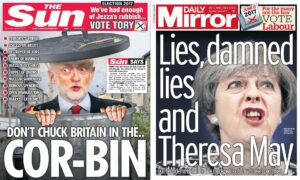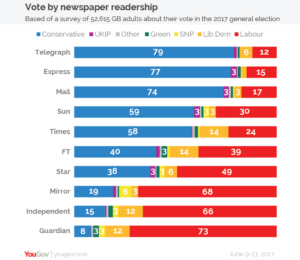Lies, damned lies and statistics
Following our blog earlier in the week about the declining influence of print in elections, two sets of figures have come to light which emphasise the trend. But they also lead to some profound questions.
It was widely reported this week that Labour won the social media war, as we had suggested on Monday. The bald numbers look poor for the Tories. Over the course of the six week election period, Jeremy Corbyn posted 925 messages on his official social media channels, gaining a combined 2.8m shares. Theresa May posted 159 messages, and they were shared a mere 130,000 times – less than 5% of Corbyn’s total.
Corbyn increased his followers on Twitter and Facebook to a combined 2.4m (there is no figure on the overlap between the two audiences, though it is likely to be significant): May manages 770,000. Labour’s official Facebook page channel had a 75% increase in likes, and 1m shares, while the Tories managed a 10% increase in likes and 360,000 shares.
But, as impressive as these numbers are (or not), they are deemed less significant by pollsters than the number who use traditional news media in all its forms. Also on Wednesday, YouGov delivered a poll of almost 53,000 people, giving a detailed breakdown of their votes in this election – by age, education, and newspaper readership.
For the media watcher, this last set of figures is the interesting one (see below). Unfortunately, YouGov have decided to stick to historical brands and weighting in order to preserve an easy method of comparison between different elections – which renders the set of figures slightly meaningless as an indication of national behaviour this year.*

Nonetheless, some sets of group behaviour are informative. For example, while the Sun and the Mirror have roughly equal NRS / Comscore totals (15.6% v 15% of the YouGov universe), the Mirror’s readers are far more politically engaged. Only 48% of Sun readers voted – and only 59% of those voted Conservative. Which means that only 30% of Sun readers actually voted Tory. By comparison, 65% of Mirror readers voted, and 68% of those voted Labour: so Mirror readers voted 44% Labour (just above the national level).
And this is probably the biggest indication that traditional media is declining in influence. If only 44% of Mirror readers – who represent 15% of the total newspaper readership – voted Labour, along with 59% of the smaller Guardian readership (13.8% by NRS), and bits and bobs from other outlets, it would have been a Conservative whitewash. So there must be other influences at play.
The fact is, of course, that if you subscribe to the official Labour / Corbyn channels, or Conservative / May channels, you are pretty much guaranteed to vote that way (unless you are a journalist who has to do it for professional reasons, or an activist on a need-to-know mission, or just a real political geek). Those 2.4m Corbyn subscribers are pretty much 2.4m guaranteed votes – whereas 2.4m newspaper readers might deliver you somewhere between 0.8m and 1.6m votes.
But more important online is the influence of unaffiliated social media channels: the people that you follow because you like their content. This is where the whole thing becomes anecdotal: no-one that I can see has done a serious study of this yet. This might explain some of the gaps between the statistics above and the actual voting pattern.
The YouGov report also does not include BARB figures, or RAJAR figures: broadcast news and factual programming reaches a huge part of the UK population. The BBC six o’clock news regularly reaches 5m. And broadcast media is bound by strict rules on impartiality, as we have discussed before, which allows viewers and/or listeners to make up their own minds. Certainly Corbyn’s ratings had a bounce following his appearances on Channel 4 news and the leader debates.
So while the stats above are far from conclusive in explaining the way the country voted on June 8th, they do illustrate some of the trends in media influence which will be particularly important as the new minority government navigates the first faltering steps of Brexit.
*There are several problems with YouGov survey as published on Wednesday. First, it includes the Independent, which was not in print at all during the election, but not i (circulation 300,000) or Metro (1.5m, and the largest daily circulation of any print product in the UK). According to YouGov’s Chris Curtis, this is because the ten brands they have named were the national newspapers when the survey was first set up, and this “brand identification” rather than actual readership makes comparison easier.
The second big problem for me is the lack of correlation between the numbers in the survey and any other objective comparison (see chart below). So, the Guardian in the YouGov survey is weighted as the newsbrand for 20% of all respondents. But among the ten titles the YouGov survey chooses, it only has 13.8% readership share by NRS / Comscore, and 2.5% share by circulation (according to ABC). On both counts, it would have been much lower had Metro and i been included. Conversely, the Daily Star has its ABC and NRS figures (7.5% and 4.5% share respectively) downgraded to a weighted average of 1.5% in this survey. Chris Curtis again explained that this was for historical reasons, but it does seem a bit arbitrary: and both historical explanations undermine the claim for it to be a snapshot of this year’s electoral trends.
There are many other anomalies too, but really only Chris Curtis and I care enough to go into further detail. I will spare you the rest.
Thank you for your patience.
enquiries@trippassociates.co.uk
Martin Tripp Associates is a London-based executive search consultancy. While we are best-known for our work in the TMT (technology, media, and telecoms) space, we have also worked with some of the world’s biggest brands on challenging senior positions. Feel free to contact us to discuss any of the issues raised in this blog.
